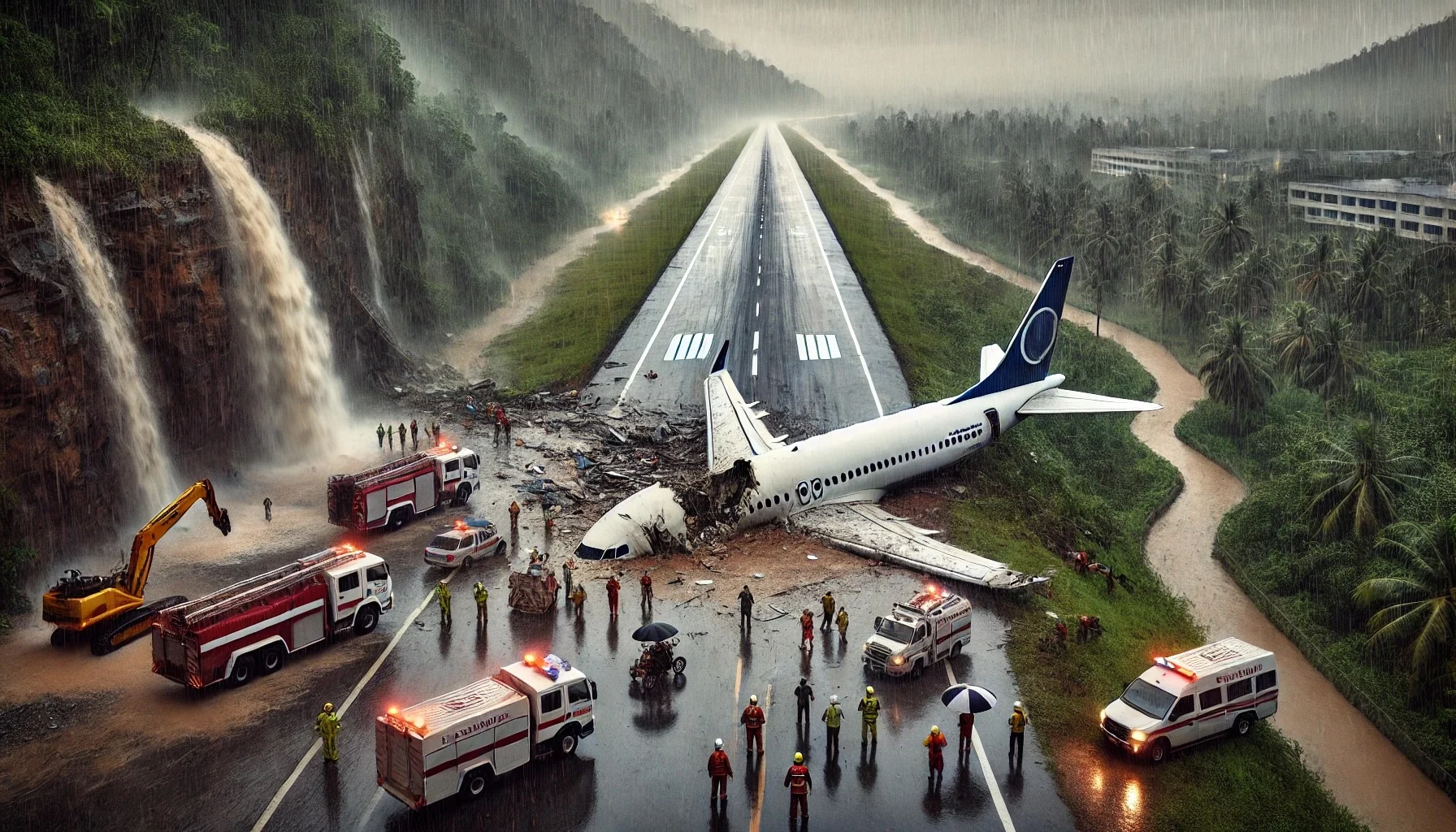
The Air India Express Flight 1344 Crash
by: The Calamity Calendar Team
August 7, 2020
In the early evening of August 7, 2020, the sky over Kerala was shrouded in heavy rain, a foreboding backdrop for Air India Express Flight 1344 as it neared Calicut International Airport. Operated under the Vande Bharat Mission to repatriate Indian citizens stranded by the global COVID-19 pandemic, the Boeing 737-800 departed from Dubai with 184 passengers and six crew members, carrying not just people but the hope of reunion in a world turned upside down by the pandemic.
A Challenging Approach
Calicut International Airport, known as Karipur Airport, is no ordinary landing site. As one of India’s tabletop airports, it is perched on a plateau with limited space at the runway’s end. These geographical features make landing there a feat in ideal conditions, but as monsoon rains lashed Kerala, visibility plummeted, and the runway became slick and treacherous.
Flight 1344 approached at approximately 7:40 PM IST, and the pilots, aware of the difficulties posed by the conditions, prepared for a challenging descent. Their first attempt to land on Runway 28 was abandoned due to poor visibility and high winds, prompting a go-around to try once more. It was a critical decision in a series of events that would culminate in disaster.
The Fatal Second Attempt
Cleared for a second attempt, this time on Runway 10, the pilots faced the daunting task of landing amidst the relentless rain. As the aircraft touched down, the wet runway, combined with a tailwind, proved unforgiving. The plane skidded uncontrollably, unable to stop within the runway’s confines.
Thanks for subscribing!
In those harrowing moments, Flight 1344 hurtled past the runway’s end, crashing through the airport’s perimeter wall and plunging into a gorge 35 feet deep. The aircraft’s fuselage split in two, a devastating scene that echoed the violent impact.
The Immediate Aftermath
The crash site was chaotic. Emergency services, police, and fire teams rushed to the scene, assisted by local residents who bravely ventured into the night to help rescue efforts. Amidst the wreckage, survivors were pulled from the debris, some critically injured, others bewildered and in shock. Despite the valiant efforts, 21 lives were tragically lost, including both pilots, and more than 100 passengers suffered injuries.
An Unprecedented Tragedy
The loss was felt deeply, a sharp reminder of the complexities and dangers inherent in aviation. The aftermath revealed not just the physical wreckage of the aircraft, now completely destroyed, but also the vulnerability of airports like Karipur under such conditions.
Investigations and Responses
In the wake of the crash, the Directorate General of Civil Aviation (DGCA) and the Aircraft Accident Investigation Bureau (AAIB) launched a comprehensive investigation. The recovery of the Black Box and Cockpit Voice Recorder was crucial in piecing together the moments leading up to the disaster.
The investigation’s findings pointed primarily to human error exacerbated by the adverse weather conditions. The pilots had attempted a high-risk landing, misjudging the runway’s capacity to handle the conditions that evening. The combination of a wet runway and a tailwind was a critical factor in the aircraft overshooting the runway.
Policy Changes and Safety Measures
This tragic incident prompted significant scrutiny and led to a series of recommendations to enhance safety at tabletop airports. Measures included improved runway safety features, like extended arrestor beds and clearer signage, as well as enhanced pilot training focused on handling challenging weather conditions.
Moreover, the incident prompted a review of operational guidelines during adverse weather, ensuring that decisions to land under such conditions are made with greater caution and consideration of all factors.
Compensation and Acknowledgement
In the aftermath, Air India Express announced compensation for the families of those who had perished and for the survivors who bore the scars of the night, both physical and emotional. The gesture was a small balm for a wound that would take time and reflection to heal.
Lessons and Legacies
The crash of Flight 1344 underscored the complexities of aviation safety, particularly under challenging conditions, and highlighted the urgent need for rigorous protocols and training. It served as a sobering reminder of the inherent risks of air travel, even as it reaffirmed a commitment to learning from tragedy to prevent future occurrences.
As the aviation industry continues to evolve, the lessons from this crash will play a crucial role in shaping safer skies, ensuring that the memories of those lost are honored through improved safety measures and more stringent operational guidelines. The legacy of Flight 1344 is a testament to resilience and the relentless pursuit of progress in aviation safety.
Stay in the Loop!
Become a Calamity Insider and get exclusive Calamity Calendar updates delivered straight to your inbox.
Thanks! You're now subscribed.